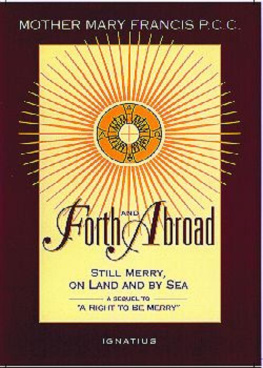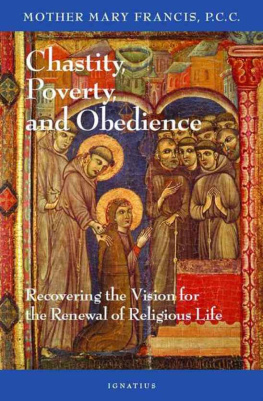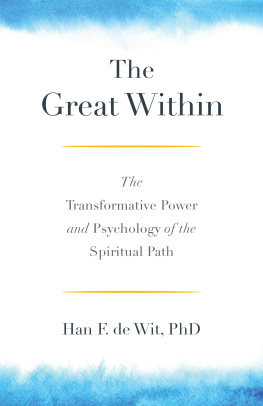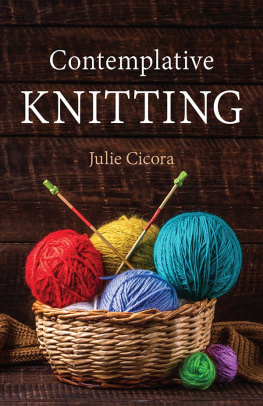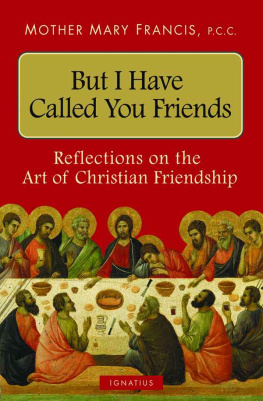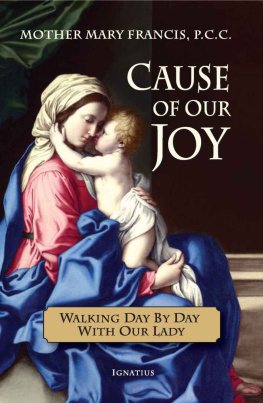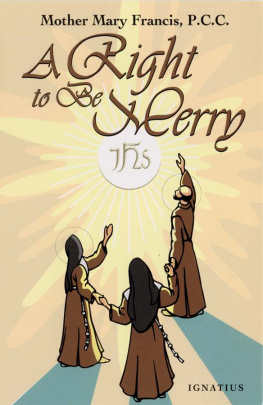Forth and Abroad
Mother Mary Francis, P.C.C.
Forth and Abroad
Still Merry on
Land and by Sea
A Sequel to
A Right to Be Merry

Ignatius Press San Francisco
Cover illustration by Sister Mary Pius, P.C.C.
Cover design by Riz Boncan Marsella
1997 Ignatius Press, San Francisco
All rights reserved
ISBN 0-89870-589-4
Library of Congress catalogue number 96-83639
Printed in the United States of America
To my eighteen thousand sisters
the Poor Clare Nuns
spread over the world
Contents
Preface
Once upon a time there was a little book called A Right to Be Merry . It was written because we needed, urgently, to repair our enthusiastically leaking roof and had no money to accomplish that. Our founding abbess, Mother Immaculata, saw an ad in a Catholic paper: $1,000.00 prize for a first book by an unknown author. Realizing that I was highly qualified by reason of never having written a book and being thoroughly unknown, Mother told me to write a book. Obedience simplifies all things. So, there was no room for questioning and even less for objecting. It remained only to inquire what the book should be about. I dont care, replied Mother Immaculata, giving this yet further evidence of her broad, sweeping vision and knowledge of how to delegate work. However she added, if not ominously at least definitively: But win the prize. We have to get the roof repaired. That made my plan of procedure clear. So, I rummaged about in the piles of old, used Christmas cards people had given us, flattened them out (cards, not donors), and wrote the story of our Poor Clare life on the backs of the cards.
Choosing the subject of the book posed no problem. It was only a clear matter of writing about what I love with all my heart: our blessed vocation, our way of life. On old Christmas cards, and in oddments of time here and there, it was written. We never entered the contest because Frank Sheed, dinner guest at the home of a professor-friend of ours at Notre Dame University, picked up the few typescript chapters Id sent to said friend and asked to publish them and the chapters to come, sight unseen.
So many, in the ensuing years, have asked for a sequel to A Right to Be Merry . This is it. Sequels are oftentimes quite deadly. We hope this one is not. One ecumenical council and five foundations later, were still merry.
Chapter I
First Summoning
What does she see? I inquired of myself. I did not inquire directly of Sister Anthony, whose unswerving gaze at a point on the ceiling of her little infirmary cell was intriguing me, because she was too busy. Sister Anthony was dying, and she was giving to this present task the same focused attention she had given to every other charge and detail of her sixty years of Poor Clare living. She seemed clearly to be already in another world where we could not follow her. Intent, unblinking, she lay there. And I, perched on a high stool beside her bed, sat there. One just does not ask questions at such a moment in such a situation. But then the young novice mistress, her little flock of novices and postulants fluttering about her, came in.
It was time for the changing of the love-guard that kept watch beside Sister Anthony all the days and nights of those final weeks of her last November in Roswell. And our hope-for-the-future contingent very much wanted to know what Sister Anthony was seeing at that point above her which so compelled her gaze. Having none of the inhibiting hesitations of their abbess, they sought clear explanations, no matter the hour or the situation. Do you see our Blessed Mother, Sister Anthony? the self-appointed spokesman wanted to know, probably hoping against hope for an affirmative answer sure to elicit a whole litany of subsequent inquiries. It was a dramatic moment as Sister Anthony slowly turned her gaze away from its upward intentedness to the little hopefuls around her. She studied her young questioner with something that made me think of the Last Judgment. I could only reflect within myself that dying Sister Anthony looked strikingly like living Sister Anthony had always looked: businesslike, no-nonsense, practical, and conclusive. The eager question still hung upon the air: Do you see our Blessed Mother? No, dear Sister, replied Sister Anthony in a tone that left no doubt as to her opinion about seeking after the phenomenal. It was, in fact, the briefest and perhaps most effective instruction I have ever had regarding the perils of desiring visions and all such. After this devastating negative, Sister Anthony returned to her study of the ceiling.
Then, on November 28, 1969, having just attained her eighty-first year, Sister Anthony departed to initiate our first foundation, a foundation assuredly destined to endure by reason of its being made in eternity. And it was an especially fitting time, since the Roswell foundation was just come of age, it being twenty-one years precisely that November since eight of us had come to put down our Poor Clare roots in an old white farmhouse just outside the city limits of Roswell. We had come by Gods grace to number thirty this historic November, but we still held fast to our conviction that foundresses scarcely ever remain upon this earth long enough to be part of yet another foundation. This one newly made by Sister Anthony in eternity would, we could be certain, grow. And even as we sorely missed her unique earthly presence, we could without doubt anticipate each of us returning to her company to enlarge Roswells foundation in eternity during the unfolding years. No one, of course, had any intention of going anywhere else. Eternal rest grant to her, O Lord, we besought that Lord for our Sister Anthony. Only, she did not rest. Things began happening.
Less than two years after the summoning voice of God had spoken his Forth and abroad! to our first vicaress in Roswell, he was to sound that call to five of us for Roswells first foundation in the vestibule of eternity, that is to say, upon earth. Sister Anthony had always wanted to get things done on earth right away. It seemed evident that she was continuing this mode and manner in the celestial realm. It was likewise manifest that God endorsed this plan of action and had, as a matter of observable fact, initiated it from the beginning. That is, he again made himself quite and painfully clear.
There was a vacated monastery in a southern State, and there was a wonderful bishop who did not wish it to remain such. Will you come? he asked us. In the kindest and gentlest manner, the good bishop yet made it discomfitingly clear that if Poor Clare life was not to be any longer in his diocese, it would obviously be our fault. If the Lord Jesus was obliged to fold his tabernacle-tent and take his Eucharistic departure, the responsibility for such a heartrending exodus would be ours. There followed, after a short measure of time allowed us to emerge from initial shock, a series of community discussions. It was just early post Vatican II, and collegiality was the watchword of the hour. We were very collegial, each sister contributing her light on the situation and her considered opinion. The fact that all the lights were one light and all the opinions the same would doubtless be considered deplorable in any age of enlightenment, much less the somewhat panting atmosphere of the early seventies. But there was just no gainsaying it: we all produced one and the same scenario as we had this thing out with God. It could have been set down in script like this:
BISHOP: This monastery must needs be re-peopled.
ROSWELL COMMUNITY: Assuredly. We shall pray for that.
BISHOP: But you are the ones who must do it.

